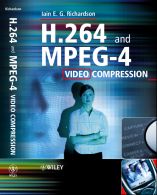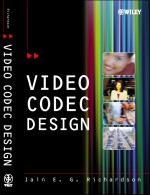
| Video Technology Magazine | May 2004 |
For more information see: John Sokol's Resume
"After 11 days of collecting results Roberto Amorim today announced the results of his 2nd Multi-Format listening test: Vorbis fork AoTuV scored the highest and ranks as the winner together with open source contender Musepack closely followed by Apple's AAC implementation and LAME MP3, which improved markably since last year thanks to further tunings of its VBR model done by Gabriel Bouvigne. Sony's ATRAC3 format ranks last after WMA on the third place. The suprising success of AoTuV (compared to last year's performance of Xiph.org's reference implementation) shows the potential of Vorbis and possible room for further tuning and improvments. Take a look at the detailed results and their discussion at Hydrogenaudio.org."
 
More information is available on his web site - VCodex.com
May 14, 2004 in Sunnyvale, CA
They also have Mpeg1 & 2 on May 17,18
So far they have been talking with Maxtor and a few other companies but have faced unexpected resistance from makers unwilling to even consider anything that would change there current form factor even though the current designs overheat.
So Nisvara is seeking PVR/DVR companies that would be willing to try something new to solve their heat problem.
 Microsoft has been pushing WM9 as the new format for HD-DVD they have go so far as to even release a few movies in this format that are playable on a High End P4 system
Microsoft has been pushing WM9 as the new format for HD-DVD they have go so far as to even release a few movies in this format that are playable on a High End P4 system
Article here Terminator 2 Trailer in HD WM9 HERE WM9 , MPEG-2 and H.264/MPEG4 are the only proposed HD-DVD formats that uses standard DVD Media with improved compression. The others such as BlueRay and AOD (Advanced Optical Disk) continue to use MPEG2 and increase the storage density and data rate to achieve HDTV. Here is a Power point from Philips on this DVD FAQ for more information I have talked to several companies attempting to do VC9/WM9 Decompression chips, It always amazes me how every chip company doing this seems to think they are the only people trying to do this. Most are using a typical DSP core if there smart a parallel core. I have yet to see someone make one of these that can do a higher level function in hardware such as DCT or Motion Vectors. I am still waiting to see someone put a VLE (Variable Length Encoder) on a chip instead of a the the VLD (Decoder) so compression would be simpler.
Companies already shipping WMV9 Decompresion chips are:Amphion CS7150 WMVHD Video DecoderAmphion also has a H.264 Video Decoder (AVC/MPEG-4 Part 10), the CS7050 and several Mpeg4 encoders and decoders. Sigma designs has the EM8620L Decoder Other possiblites for realtime decoding are Analog Devices ADSP-BF533, Micronas MDE9500, Philips, PNX1500, Intel PXA255,
Licensing for the VC9 codexUp to this point Microsoft has been the only company licensing the Windows Media VC9 Codec, I'm told example source is also available from them. But this is more complicated since VC9 is a derivative of MPEG-4.
ExtremeTech - Video Codec Shootout WMV9, Divx5.1.1 and QT6.5 (Sorenson3), QT6.5 (Apple MPEG-4) confrontation experiment of picture quality and encoding time etc. Doom9 has done a codec comparison and XVID was one of the best codecs tested. Codec's tested were 3ivX, DivX 3 (SBC), DivX5, ffvfw (version of ffmpeg for VFW video for windows), Nero Digital MPEG-4, RealNetworks RV9, On2 VP6, XviD. Link to Codec ShootOut Part 1 | Part 2
Free Advertising is also welcome. More info contact the Editor:
H263L.com H324.com DVBS.com PNX1300.com TM1300.com TrimediaVideo.com 8vsb.com HDTVRecord.com StreamHDTV.com StreamingHDTV.com 6GHz.com Reaction-Time.com Audio-Frequency.com FirstInvented.com FrequencyModulated.com Interested Parties can contact:
by Jesse Monroy, Jr. Jesse discusses some of the challenges of streaming video and the problems that stem from poor assumptions in it's original design when trying to stream MPEG Video.
SourceForge project directory with source
The Register Article
 European Cable Communications Association, ECCA has released a spec for interoperable cableboxes for Europe. Dr. Manuel Cubero, Vice President digital TV of Kabel Deutschland and Incoming ECCA President points out: “The development of the ECCA set-top box specification is a great initiative as it facilitates a fast transition from analogue to digital, one of the key items on our agenda. It is essentialfor the speedy development of digital TV via cable to have low-priced, cable-ready, interoperable IRDs commercially available very soon.” Original Press Release here
|
I'm not just talking about the Smart Phones with Windows CE that has a striped down Windows Media Player or the PalmOS based phones, but many of the Camera Phones can now capture about 10 seconds of 3GPP Video at 176x144 at 15fps and save it, send it over IRDA or BlueTooth and send it to other phones using MMS (Multimedia Messaging Service). Some can also receive live streams over GPRS and Internet access.
 Video and Streaming in Nokia Phones from the Nokia Forum I am working with a group OverCell to stream video and audio to these phones. I have had some success with the Apple Quicktime and Darwin Steaming Server (DSS), and the RealNetworks Helix server. It seems like Apple and Real have taken a serious interest in creating tools for Cell Phone Video. I was surprised to find that by registering for $29.95 the Apple QuickTime Player I could export .3gp files that could be played directly on cell phones or streamed using the DSS. One think to keep in mind with streaming RTSP is any time to be streamed requires a Hinted MPEG-4 file. This uses a special track in the transport stream called a Hint Track that contains the RTP packed marked off by the compression codec to all the streaming server to know where to start and end UDP packets. There are also a number of good tools for Unix/Linux for creating Hinted MPEG-4 and .3gp files. FFMPEG, TransCode, MPEG4IP are the one that seem to stand out. Also for Audio there is FAAD at AudioCoding.com this is the ultimate MPEG audio coding package.
These boards are from ViewCast some support SimulStreamtm and "Multiple Bit Rate (MBR)" which is cool for allowing multiple programs to capture from the same source at different frame rates and resolutions, but this is just a software trick in the driver. A better streaming application would'nt need this. The Osprey 100 is really just a Conexant BT878 or CX23881 based card, and sells for $150 while other vendors sell these cards from $20 to $50 each. Some of their higher end cards do have professional conenctors, but I don't really see any improvement using these cards. If anything inproving the capture source like upgrading to a good 3CCD camera makes much more of a difference. Here is a list and images and technical details to all the video boards supported by the Linux BTTV Driver. Video Capture board Gallery
USD-TV U.S. Digital Television, Inc. Is using conventional TV tranmitters to provide HDTV service in Salt Lake City, Albuquerque and Las Vegas, and is only $20 a month Voom VOOM is a satellite television service, provided by Rainbow DBS, a subsidiary of Cablevision Systems Corporation (NYSE: CVC). Akimbo Akimbo is HDTV streaming over the Internet to a broadband connection at home. Akimbo has offices in Los Angeles and San Mateo, California, and is backed by Silicon Valley investment firms Draper Fisher Jurvetson, Sprout Group, and Zone Ventures. I saw an interesting announcment back in April that all of these will use or at least are interested in Windows Media 9 for their HTDV Broadcasts! Microsoft Announces Leading Broadcast Companies to Deploy Products and Services Based on Windows Media 9 Series Interesting related article
Many cable providers get their HD Content from HDNet:
I'm sure USDTV, VOOM and Akimbo must all get much of their content from here as well. I also see a lot of references to Shanghai Broadcasting Lab although I can not get this to translate.
high definition HD-VHS players sell for around $550 to $1300.
The HDTV tapes will not work with analog VCRs or analog TVs. Yahoo sells HD-VHS Tapes from HDNet's HDTV Content
HomePNA 3.0, can reach 128 Mbps, (not KBps) and supports Quality of Service (QoS). allowing it to transport IEEE1394 data. "By reaching 128Mbps and beyond, HomePNA 3.0 lays the foundation for the next generation of home networking solutions geared toward multimedia applications. By addressing such issues as QoS for such applications as streaming video and audio, HomePNA 3.0 addresses the critical need of a plethora of vendors and service providers for a reliable, low-cost, and easy-to-use backbone solution that can complement additional networking technologies." said Kurt Scherf, vice president of research at Park Associates, a Dallas-based market research and consulting company. The International Telecommunication Union (ITU) has already adopted global phoneline networking standards G.989.1, G989.2 and G989.3 based on the HomePNA 2.0 specification. HomePNA members companies are working together and will shortly present recommendations based on version 3.0 to the ITU-T. HomePNA 3.0 physical interface is based on version 2.0 physical layer technology and is fully backwards compatable. HomePNA 3.0 specification are being developed to power a variety of devices including pre-configured PCs, network interface cards and adapters, residential gateways, broadband modems, printers, multimedia devices, Internet appliances, set top boxes and consumer electronics products such as TVs, DVDs, DVRs and home entertainment systems.
This is something we video people really should keep our eyes on with companies like Xilinx already shipping parts with this built in. It could very easily become a common part of HDTV systems, and interoperate with things like OSGi(Open Services Gateway Initiative), Jini, UPnP, AVC and HAVi. AVC (Audio Video Control) and HAVi (Home Audio/Video Interoperability) already operate over IEEE1394
Other things to keep an eye on is HomeRF, Bluetooth, HiperLAN2, IEEE 802.11, HomePlug, and I'm sure we all already know about IEEE 1394 FireWire.
FMOD Sound Library Supports Windows, Linux, WinCE, Macintosh, GameCube, PS2 and XBOX! Hardware or Software? Wading the Video Stream An article at Network Computing Magazine CRS4 / Digital Media Systems group This is a very interesting group out of Italy doing R&D into MP@ML, MHEG-5 MPH and many other video related technologies ATi Introduces the HDTV Wonder Seems like the basis for great HDTV PVR's Video Card Forum Specializing in ATI and NVidia TV Predictions .com - Unconventional Analysis of TV Technology Lots of interesting HDTV Articles TV Technology .com Another Video Magazine online and in Print Advanced Graphics Algorithms, by Henri Hakl Amara's Wavelet Page Links and resources on wavelet signal processing
|
||||||||||||||||||||||||||||||||||||||||||||||
Copyright © 2004, John L. Sokol
|
|

